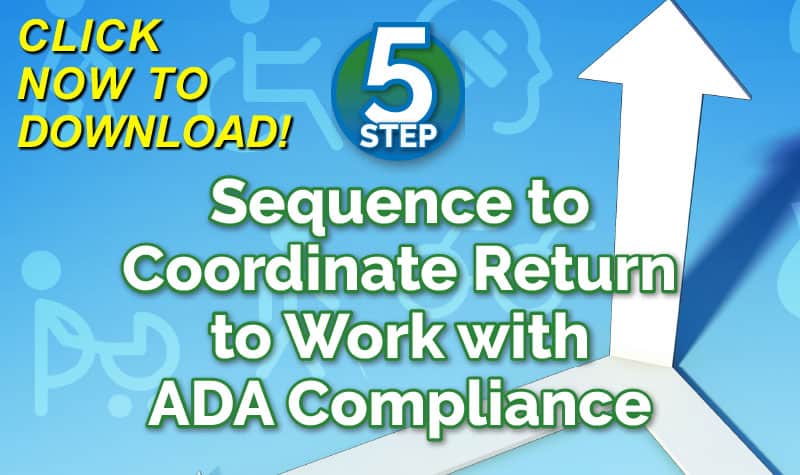
This post is one in a 3-part series:
A follow-training on How to Coordinate Return to Work with ADA Compliance initiated additional questions:
- ADA – If light duty cannot be accommodated, should FMLA run concurrently?
- ADA – Do All Work Comp Injuries Fall Under the Americans with Disabilities Act Amendments Act (ADAAA)?
- ADA – Is it against the law not to hire a person with a disability for a physical position?
From an employer standpoint when commencing the interactive process, i.e. scheduling meetings with the employee; however, the employee either disagrees to meet or fails to respond how many efforts does an employer have to make to ensure they have conducted their due diligence?
The employee has a duty to engage in the interactive process. That said, there is no specific number of attempts that the employer must make. It could also depend on the reason why the employee is not cooperating – the answer might be different, for example, depending on whether he failed to respond because he was unconscious or because he simply couldn’t be bothered.
Click Link to Access Free PDF Download
“5-Step Sequence to Coordinate Return-to-Work with ADA Compliance”
The employer should make a good faith effort to develop a solution that will work, according to the information available. If the individual refuses to provide necessary information, then the employer will not know how to modify its proposal so that it’s acceptable. In a situation like that, it seems to me that the options are for the employee are to accept the proposed solution, provide the missing information, or be considered absent.
As is the case with a transitional duty policy in workers comp cost containment best practices, good communication systems are an effective solution. It is recommended that the employer provide an ‘employee brochure’ which contains basic information about workers compensation, the ADA, interactive process, and each party’s roles and responsibilities.
What is your recommendation on the interactive process so that it does not come across as coercive with the employer coming up with all the solutions and the employee countering on how it won’t work. Then the employer comes up with another solution, etc.?
It seems like you are raising both a legal and an interpersonal issue. Legally, both the employer and the employee have a duty to engage in the interactive process. If the employee refuses to give the employer information that is necessary to come up with an acceptable solution, then the employee has caused the process to break down. (Note, though, that it’s also possible in a situation like this that the employee feels the same way – that he or she is offering a solution that the employer is dismissing out of hand, without listening to what is being said about his or her medical needs. If an employer rejects a reasonable accommodation that would be effective, and would not impose undue hardship on the employer, and instead insists on a different reasonable accommodation that would cause pain, prolong recovery, etc., then the employer will be liable. Both sides have to make a good faith effort to come up with a solution that meets everyone’s needs.)
Whether the process seems coercive to the person sounds like an interpersonal issue. If the employer really is making a good faith effort to come up with a solution that does not cause pain, reinjury, prolonged recovery, etc., and is taking into account all of the relevant information that is available, then the employee shouldn’t feel any more coerced than someone who doesn’t have a disability and is required to come to work.
From a practical standpoint, the feeling of coercion often comes from improper expectations, or the fear of the unknown. Employers can avoid mistrust by setting the proper employee expectations prior to injury. Communication should include formal items such as brochures and letters explaining policies and procedures, as well as informal communication such as conversations, phone calls, and face-to-face encounters.
How about after we go through the interactive process and the employee returns to work in a transitional duty job and then becomes “stressed” by the new transitional duties. How do we address the challenge of stress allegations as a work-related injury vs. a temporary workplace employee relations issue?
“Stress” is a tricky word because it can mean so many things. It’s possible that the employee is informing you that the transitional program is exacerbating the injury, causing pain, or increasing risk of reinjury. Communication with the employee and with your medical provider throughout this process is critical. A good practice is to ask the physician to give as much information as possible about what the employee can and can’t do on the job, at the very first appointment. With this information, you can assign a transition duty position that is within the individual’s current capabilities.
Instead, the employee may be informing you that the work is causing, triggering, or exacerbating a mental health condition like depression, panic disorder, or generalized anxiety disorder. If this happens, then the employer can ask for medical documentation of the existence of the mental disorder from a medical professional. It can also ask for documentation of the resulting functional limitations. Those limitations would then be added to the other ones to generate a comprehensive set of workplace restrictions. The interactive process would then be required to determine whether a reasonable accommodation would allow the individual to return to work, and, if not, whether additional unpaid leave would allow the person to recover sufficiently to return.
The employee also might simply be saying that he or she is experiencing normal workplace stress. If the stress does not arise from a disability, then the employee may be required to perform the duties. The ADA only requires reasonable accommodations that overcome workplace barriers caused by disabilities. Work can be stressful for anyone, but employees are routinely required to do it anyway.
Author:

Dr. Konopasky joined EEOC after receiving his J.D. from Stanford Law School. Prior to law school, he received his Ph.D. in philosophy from Princeton University, and served as an adjunct professor of philosophy at Rutgers University, Tulane University, and the University of New Orleans.
Author:

To Learn Step-By-Step instructions to create your Return to Work program, Purchase Your Ultimate Guide To Mastering Workers Comp Costs.








